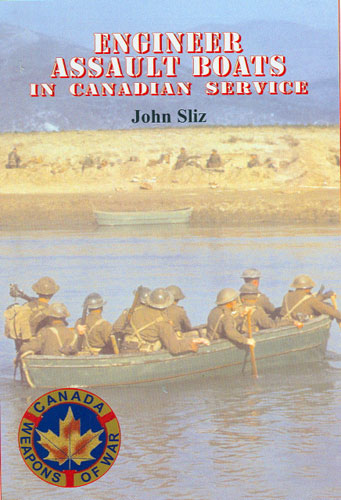|
|
|
|
| Home > Reviews > Canada > "Weapons of War" Series; Engineer Assault Boats in Canadian Service by John Sliz; Service Publications, Ottawa, Ontario, Canada, 2006 |
Engineer Assault Boats in Canadian Service
Reviewed by Cookie Sewell
Summary
| Title and Publisher: | "Weapons of War" Series; Engineer Assault Boats in Canadian Service by John Sliz; Service Publications, Ottawa, Ontario, Canada, 2006 |
| ISBN: | 1-894581-43-1 |
| Media and Contents: | 24 pp. with B&W photos |
| Price: | CDN$9.95 available online from http://www.servicepub.com |
| Review Type: | FirstRead |
| Advantages: | Good, clearcut description of a relatively unknown aspect of engineer operations and how the Canadian and Commonwealth armies approached them |
| Disadvantages: | Modelers may regret not having more detail information on specific items or how to model them |
| Recommendation: | Highly Recommended for all "picks and shovels" and Commonwealth fans |
FirstRead
 Probably
the only passing information most of us have seen on folding boat
operations in WWII comes from the film "A Bridge Too Far" when
General Gavin (Ryan O'Neal) asks one of his majors (Robert Redford)
to use British folding boats to cross the Rhein and secure the
opposite end of Neimegen bridge before the Germans can blow it up.
The crossing is held up until the boats arrive, and then is made
under fire in broad daylight with only chemical smoke for cover. The
attack is successful, as Redford takes the bridge just in time for
XXX Corps tanks to cross.
Probably
the only passing information most of us have seen on folding boat
operations in WWII comes from the film "A Bridge Too Far" when
General Gavin (Ryan O'Neal) asks one of his majors (Robert Redford)
to use British folding boats to cross the Rhein and secure the
opposite end of Neimegen bridge before the Germans can blow it up.
The crossing is held up until the boats arrive, and then is made
under fire in broad daylight with only chemical smoke for cover. The
attack is successful, as Redford takes the bridge just in time for
XXX Corps tanks to cross.
Aside from that one film segment, few of us have any clue about these boats.
This new book from Service, written
by one of the few historians covering Canadian engineer operations,
is the first one to examine them at any length. Four types of boats
are covered: Folding Boat Equipment, Reconnaissance Boats, Assault
Boats (the ones used in the film), and Storm Boats.
Folding Boat Equipment was produced in three marks and was basically
a general purpose boat, which could be used for ferrying troops or
equipment or combined to be used as pontoons for bridging. They were
made with sloped bow and stern sections, weighed around 940-1000
pounds in action, and three could be loaded on a custom modified US
Diamond T 4-ton 6 x 6 truck. Kit for these boats included a
boathook, five 10 foot oars, a tin bailer (bucket) and a mop!
The Reconnaissance Boat was a small two-man inflatable rubber boat
about the size of a life raft and was designed for use as a stealthy
craft to get scouts across water obstacles or for engineer
reconnaissance of the same. These were used in the withdrawal of the
British 1st Airborne Division from Arnhem in 1944.
The Assault Boat was a more common boat, created with a plywood
bottom and canvas sides with a wood gunwale held in place by locking
struts. Produced in three marks, the Mark III version of this boat
was 16 feet 8 inches long and 5 feet 5 inches in beam and able to
carry 16 men with a boat crew of two, but normally due to combat kit
it only was used for carrying 11 men with the two-man crew. It
weighed 350 pounds.
The Storm Boat was designed to be used as a fast craft for making
opposed crossings, and could carry items of equipment up to the size
of a jeep or 6-pdr antitank gun with the proper loading equipment
and channel-type racks. Also used to evacuate the British 1st
Airborne Division at Arnhem, these 1500 pound boats were powered by
outboard engines and could reach speeds of up to 20 knots empty and
6 knots loaded to capacity. Originally provided with quirky Johnson
22 HP or Evinrude 50 HP outboards, they later switched to British
Seagull 4 HP motors.
One thing generally not brought out was that once the Invasion of
the Continent took place, engineering equipment such as this was
pooled, with US, Canadian and British engineer units supporting all
three forces with the same equipment, but by and large each nation
stuck to its own organic designs.
Overall this is an offbeat but interesting little book, and provides
1/48 scale plans of the four boat types covered.
Highly Recommended.
Thanks to
Clive Law for the review copy.
Text and Images by
Cookie Sewell
Page Created 04 November, 2006
Page Last Updated
25 January, 2007
